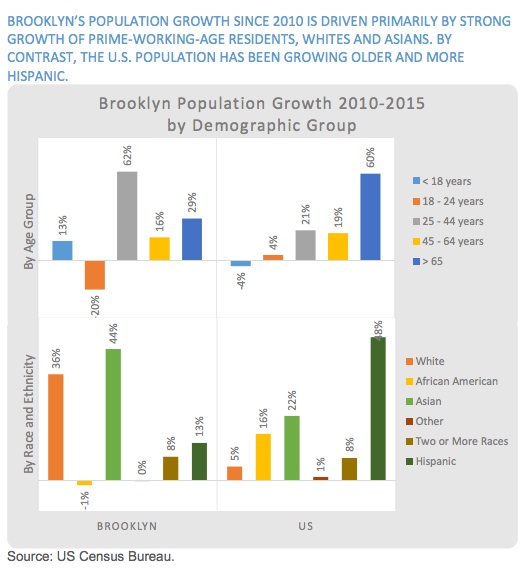A September 2016 report ECONOMIC ASSESSMENT OF THE BROOKLYN ECONOMY – 2016 UPDATE, prepared for the Brooklyn Chamber of Commerce, offers some perspective on both gentrification and the market for new housing.
The statistics it offers are through 2015, and I have not been able to find 2016 statistics. Notably, a 1.1% population growth from 2010-2014 turned into a .6% growth in 2015, largely attributable to a net loss in domestic migration (more people moving out).
The report is optimistic about growth and, indeed, there is evidence. Consider that a 2013 report from the Department of City Planning (DCP) predicted (p. 3) that Brooklyn's population would reach 2.68 million by 2020. However, DCP estimated the population at 2.63 million by 2016.
But if the rate of growth continues to be slow, that would raise questions about the market for luxury housing, including in projects like Atlantic Yards/Pacific Park.
Demographic trends
Note growth in white and Asian residents, and zero growth in African-American population, likely because of that domestic migration.
Significant poverty
Brooklyn's poverty rate is well above the city and national averages, at 23.4%, and it has grown from 21.8% since 2009. That said, the Chamber report says that the rate of growth is less than the rest of the city and that poverty peaked at 31.6% in 1993.
Poverty varies
Note that poverty in Brooklyn cannot be defined by one set of neighborhoods, building types, or demographic groups. The report states:

Note that, while Brooklyn has a significant high poverty rate among blacks and Latinos, especially in and around neighborhoods with a high concentration of public housing projects, it has an unusually high white poverty rate for a gentrified city, as noted by the figures for Borough Park.
That's because Brooklyn has a large number of poor Orthodox Jews from Hasidic neighborhoods, which typically have large families and in many cases little secular education.
The statistics it offers are through 2015, and I have not been able to find 2016 statistics. Notably, a 1.1% population growth from 2010-2014 turned into a .6% growth in 2015, largely attributable to a net loss in domestic migration (more people moving out).
The report is optimistic about growth and, indeed, there is evidence. Consider that a 2013 report from the Department of City Planning (DCP) predicted (p. 3) that Brooklyn's population would reach 2.68 million by 2020. However, DCP estimated the population at 2.63 million by 2016.
But if the rate of growth continues to be slow, that would raise questions about the market for luxury housing, including in projects like Atlantic Yards/Pacific Park.
Demographic trends
Note growth in white and Asian residents, and zero growth in African-American population, likely because of that domestic migration.
Significant poverty
Brooklyn's poverty rate is well above the city and national averages, at 23.4%, and it has grown from 21.8% since 2009. That said, the Chamber report says that the rate of growth is less than the rest of the city and that poverty peaked at 31.6% in 1993.
Poverty varies
Note that poverty in Brooklyn cannot be defined by one set of neighborhoods, building types, or demographic groups. The report states:
Poverty in Brooklyn is seen throughout the borough but concentrates in certain neighborhoods such as Borough Park, Brownsville/Ocean Hill, and East New York/Starrett City. The neighborhoods with the lowest poverty are Brooklyn Heights/Fort Greene and Park Slope/Carroll Gardens...
Poverty rates have decreased the most in northern Brooklyn neighborhoods, such as Williamsburg/Greenpoint, Bushwick, North Crown Heights/Prospect Heights, and Fort Greene. Meanwhile, poverty rates increased the most in the southern portion of the Borough (Coney Island and Bay Ridge).

Note that, while Brooklyn has a significant high poverty rate among blacks and Latinos, especially in and around neighborhoods with a high concentration of public housing projects, it has an unusually high white poverty rate for a gentrified city, as noted by the figures for Borough Park.
That's because Brooklyn has a large number of poor Orthodox Jews from Hasidic neighborhoods, which typically have large families and in many cases little secular education.




Comments
Post a Comment